COMMENT OF THE DAY: GRADING THE REPLACEMENTS “I’d love to see any examples you can provide of [lovely architecture] being replaced by a poorly built McMansion. For every one you might find, I can show you a thousand where a tiny, usless, worn out, obsolete, shack was town down and replaced with one or more new, modern, luxurious, atractive homes. Are they all perfect? Certainly not. But I think the transformation that has occurred in the Inner Loop over the past 25 years is nothing short of amazing. I only hope [it] can continue for another 25 years. Better homes inside the Loop. Better apartments inside the Loop. More people inside the Loop. More money inside the Loop. More shopping inside the Loop. More restaurants inside the Loop. More jobs inside the Loop. More density. More energy. More everything.” [Bernard, commenting on Comment of the Day: What Happens To Those Small, Stylin’ Inner-Loop Homes?]
Houston History
WHEN WESTHEIMER WAS FOR CRUISING John Nova Lomax reminisces: “This was Oil Bust Houston, and it looked then like Montrose might become a full-on slum. There were no condos along ‘Theimer (as it was often called by the mullet set) and few fancy restaurants. From Montrose Boulevard all the way to what is now called Midtown, Westheimer was lined with little more than one “modeling studio” after another, and it seems like there were even more tattoo shops than there are now. The denizens and visitors to these businesses (not to mention the street hustlers, drag queens, punks and Guardian Angels that still lurk in the area) provided plenty for the hordes of suburbanites — getting their first taste of freedom and big city life — to gawk at from the safety of their Blazers and Cutlasses. . . . on weekend nights, Westheimer would be bumper-to-bumper from Bagby to well past Buffalo Speedway, and sometimes all the way out to the Galleria, a phantasmagoria of teenage hormones and sound-collisions: car-horns, engines revving, and squealing girls, the hiss-and-almost-subsonic bass rumble of ‘Paul Revere’ booming from a Jeep Cherokee interlocking with a Honda CRX chirping out that inane ‘Two of Hearts’ pop ditty or the root canal Teutonic skronk of that ‘Warm Leatherette’ monstrosity.” [Hair Balls]
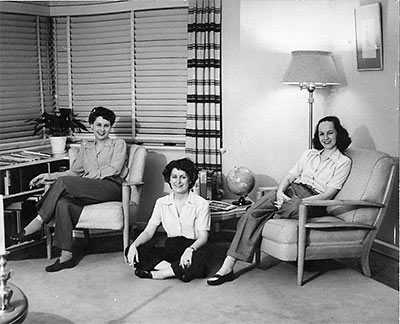
Note: Updated below.
So tell me, whatever happened to . . . those Wilshire Village Apartments? Houston photographer Sarah Lipscomb stumbled across a couple of classic interior shots of the then-new apartment complex while poking through old photos a few months ago with her aunt, Johnna Lee Muller.
Writes Lipscomb:
They didn’t have internet in those days but they got to smoke, read magazines and look at globes.
Another view of home entertainment in the early 1940s, Wilshire Village-style:
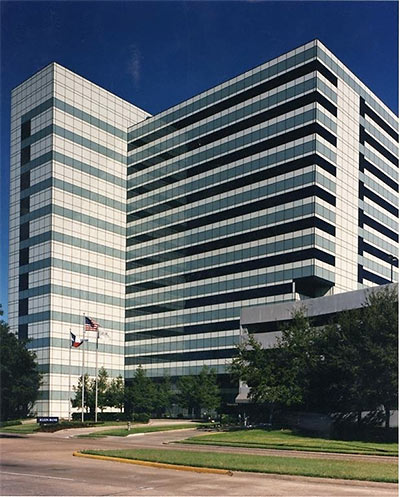
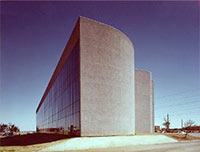 Diehard Modernist architect Charles Gwathmey, dubbed one of the “New York Five” (along with Peter Eisenman, Michael Graves, Richard Meier, and John Hejduk) in the early 1970s, passed away yesterday in Manhattan of esophageal cancer. Gwathmey, who was 71, was probably most famous for his addition to Frank Lloyd Wright’s Guggenheim Museum, which his firm, Gwathmey Siegel & Associates Architects, completed in 1992.
Diehard Modernist architect Charles Gwathmey, dubbed one of the “New York Five” (along with Peter Eisenman, Michael Graves, Richard Meier, and John Hejduk) in the early 1970s, passed away yesterday in Manhattan of esophageal cancer. Gwathmey, who was 71, was probably most famous for his addition to Frank Lloyd Wright’s Guggenheim Museum, which his firm, Gwathmey Siegel & Associates Architects, completed in 1992.
Gwathmey-Siegel was no stranger to Houston. In the late seventies and early eighties, the firm designed a series of 4 spec office buildings that line the south side of this city’s North Belt, just southeast of the Greenspoint Mall.
Photos: LoopNet (400 N. Sam Houston Pkwy. E) and Feagins Interests (Damson Oil Bldg., 260 N. Sam Houston Pkwy. E)
To think, only a quarter-century ago here, wild Animals roamed the empty Downtown streets at night, and upstanding citizens settled their disputes with a joust.
Just how far have we come, Houston?
COMMENT OF THE DAY: BURIED LANDSCAPES OF THE HOUSTON HEIGHTS “Before developers established the heights and its various neighboring subdivisions, a massive filling project took placed. It was pretty much a landfill for the City of Houston. . . . Developer clear cut the existing pine forest (the oaks pretty much only existed near the bayous and tribs) and filled in the uneven landscape. A big example is in Woodland Heights. A 60-inch storm sewer line runs in an old trib to White Oak Bayou. The line is 20-ft below the current natural ground in the area. After the line was built, the natural channel was filled in and streets placed on top. The line currently goes under many people properties and houses and many don’t know it exists. . . . Outside of that, several ox bows and other trib were filled in. A couple were not though. There is one just east of TC jester where it cross White Oak Bayou south of 11th. It has water in it. There is another just west of Yale that is dry. I’ve seen historic photos showing people jumping off the banks of the the natural streams in the bayous in the Clark Pines area (14th street west of Durham). A current development is actually being build on an undeveloped piece of land that was a site of the landfill in this oxbow. The houses are being placed on piles driven deep into the ground to avoid them from sinking or collapsing. I doubt they are telling the home buyers this. Long time residents know about it though.” [kjb434, commenting on Wet and Wild: Strip Redo on White Oak]
COMMENT OF THE DAY: INVENTING THE HEIGHTS TEARDOWN “Correction– The tearing down of old homes to build new was pioneered by Sterling Victorian Homes in the mid-late 1980s. It began on the 400 block of 22nd Street. These homes look very modest by today’s standards. It is likely true that Allegro pioneered the building of Disney-fied Hummer homes with cheese closets…” [Sheila, commenting on Scaling Back the Upscale: Allegro Builders, Downtempo]
THE ASTRODOME AND THE COLOSSEUM Ken Hoffman returns from Italy with a little perspective: “The Colosseum was originally called Amphitheatrum Flavium, and it was built by the powerful emperors Vespasian, Titus and Domitian. The Astrodome was originally called the Harris County Domed Stadium, and it was governed by former Houston Mayor and Harris County Judge Roy Hofheinz. He just thought he was an emperor. The Colosseum, after several expansions (mostly to honor a new emperor), had a seating capacity of about 65,000. It had 80 entrances and could completely fill and empty in less than five minutes. The Astrodome, after several expansions (mostly to stop Houston Oilers owner Bud Adams’ whining), had a seating capacity of 62,000 for football. It would take an hour to get out of the parking lot because of a lack of exits. Parking was cheaper in ancient times, too.” [Houston Chronicle; previously in Swamplot]
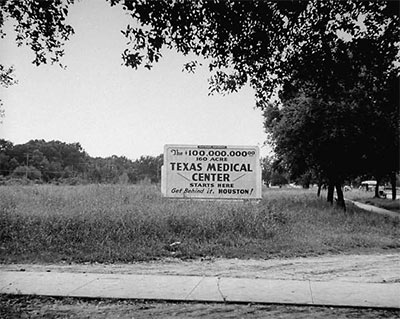
This 1946 Dmitri Kessel photo of some not-long-vacant Houston property is just one of a half-million images from the Life magazine photo archives that are now only a Google search away. Google is announcing that the entire collection of photos taken for Life magazine — about 10 million in all — will be available within the next few months. About 97 percent of these images have never been seen by the general public.
The images are available from a simple Google image search. You can single out the Life images by adding “source:life” to your search or by starting at this gateway.
Houston photophile Robert Kimberly, who’s been poring through the collection, says
There are loads of Houston pictures, but add “TX” or Texas” to narrow a search to the city. Otherwise you’ll be seeing lots of “Whitney.”
- LIFE Photo Archive available on Google Image Search [Google Blog]
- Google Hosting Time-Life Photo Archive, 10 Million Unpublished Images Now Live [Search Engine Land]
- Houston in Life Magazine: Online Photos Thanks to Google [Neon Poisoning]
Photo of sign advertising opening of Texas Medical Center, 1946: Dmitri Kessel, Life Magazine
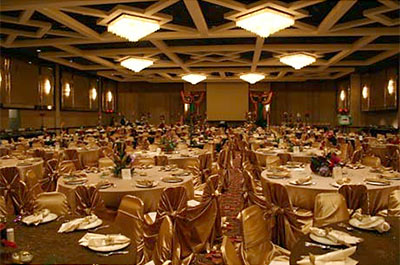
The last remaining building associated with Houston’s 1950s-era glam-magnet Shamrock Hotel is slated to be torn down, reports Cynthia Lescalleet in the West U. Examiner. The Shamrock’s former ballroom facility at 2151 W. Holcombe became the Edwin Hornberger Conference Center in 1996, nine years after the Shamrock itself was famously axed.
The Texas Medical Center has more building plans for the site:
TMC will build 250,000 square feet of office space in three floors to be added atop the Bell building, which also houses the existing parking garage, said TMC’s John Kajander. The added space is to support TMC institutions, he said.
The building housing the Hornberger’s foyer and ballroom “is nearing the end of its useful life,†he said, and will be taken down.
A little Hornberger history:
THE FINANCIAL CRISIS: KINDA LIKE FLOODING IN MEYERLAND A rising tide sinks all prices! “When Dr. Mahmoud Amin El-Gamal, chairman of the Rice economics department, is asked — as he has often been in recent days — ‘What’s is going on with our financial institutions?’ he likes to begin his answer with an analogy of local origin. ‘It’s a lot like in the 1980s when the flooding in Meyerland caused the price of all the houses in the area to go down,’ he said, ‘even those houses that did not flood.’ El-Gamal said the same can be said of mortgage securities, many of which were ‘perfectly fine,’ but had been grouped with debts that would likely continue to go unpaid.” [West University Examiner]
GALVESTON AFTER THE SECOND GREAT HURRICANE
“My sense is that Galveston will come back as a weekender community and a modest tourist vista, but that commerce not related to the tourism industry will continue to decline at an accelerated rate. My sense is that what we might see in 20 years is a community comprised of a few high-rise condos and resorts along the seawall, the ubiquitous weekender homes on the West Beach and not much else. It will certainly be easier to evacuate such a community.” [Houston’s Clear Thinkers]
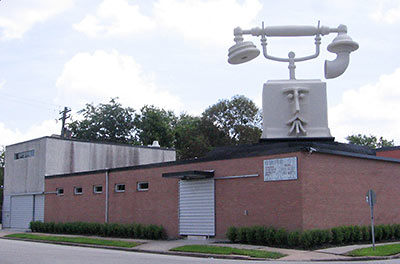
Having once graced a hotel owned by a legendary real-estate swindler, David Adickes’s telephone sculpture has quite the Houston pedigree:
Adickes first placed it on a friend’s property off SH 4 and FM 1960 before leasing to J.R. McConnell, former owner of the Grand Hotel, now called The Derek, on the corner of Westheimer Road and the West Loop.
“I said that I am going to make you a deal you cannot resist,†recalled Adickes of their arrangement. McConnell leased it for a penny a day and gave the artist $36.50. “He actually paid 10 years in advance,†Adickes said, laughing at the memory.
“Big Alex†was forced to move from that location, though, when The Grand Hotel became the Derek. It lived on Adickes’ personal lot on the corner of I-45 and Quitman Street for about six months. During that time, Adickes was forced into a back and forth battle with someone who felt the face on the phone needed its mustache painted black.
Robert Kimberly finds Big Alex in its new home at the corner of Mason and Hyde Park in Montrose, on top of Pictures Plus Prints and Framing. (Yeah, you read it here first.)
- Wednesday Night Photo Post: “Big Alex” by David Adickes [Neon Poisoning]
- ‘Big Alex’ making big smiles in Montrose (Google cache) [River Oaks Examiner, via Neon Poisoning]
- McConnell, five others named in bank fraud case [Houston Chronicle]
- McConnell first lost control, then hope [Houston Chronicle]
- A Big Telephone Tip [Swamplot]
Photo: Robert Kimberly
BOOMTOWN HOUSTON IS BACK, THOUGH MAYBE A LITTLE DUSTY “Boomtown is a strategy game simple in concept but surprisingly difficult to master. The board features several groups of properties – Rice, Montrose, River Oaks, Downtown, Bellaire, West U. and others. Four people can play, as characters Billy Bob, Fast Eddie, Aunt Hattie and Day Bue, charmingly drawn in old-fashioned style by Merriman. Each player starts out with a certain amount of money and bids against the others, trying to build real estate empires.” [Hair Balls, via Swamplot Inbox]
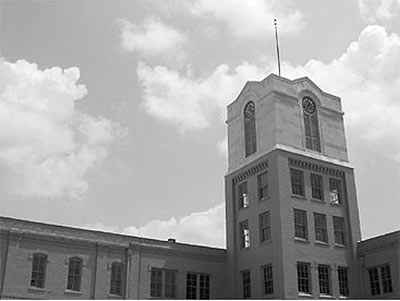
On June 1st, Scott Tycer will be opening a new wholesale and retail location of his Kraftsmen Bakery in 10,000 long-vacant square feet of the old Oriental Textile Mill on 22nd St. and Lawrence in the Heights. Also opening in the space two months later: a 1,200-square-foot restaurant with a garden patio and bar area, designed by Ferenc Dreef.
Tycer, who was the chef at Aries and then Pic on Montrose, and who runs Gravitas on Taft (which Dreef also designed), will be cooking at the restaurant, which will be called Textile. Tycer described Textile to blogger Cleverley Stone:
We’re going to build out the dining room with textiles, lots of hanging fabrics and different tablecloths on each table. This will not be your typical white-tablecloth restaurant.
Tycer is right: White tablecloths would probably not be appropriate for the space. A history of the Heights written by Sister M. Agatha of the Incarnate Word Academy and published in 1956 describes the operations of the textile mill, which was originally built in 1892 as a mattress factory:
B. J. Platt for years was superintendent of the plant that turned out a product which looked like long rolls of carpeting and which was used for pressing cotton seed oil. The plant’s capacity was about 50 rolls a day, varying in price from $200 to $400 a roll.
The textile was woven from hair. Old residents of the Heights have handed down the story that in the beginning much of the hair was obtained from China when pigtails were being discarded. But certain it is that camel’s hair in time came to be the staple used in production.
- Old Heights textile mill perfect spot for bread wholesaler [Houston Chronicle]
- Scott Tycer Weaves Together Past, Present & Future with New Restaurant [Cleverley’s Blog]
- Chapter I: The Development of a Suburban Addition [The History of Houston Heights, 1891-1918]
- more details on textile [Tasty Bits]
Photo of Oriental Textile Mill: Tasty Bits

